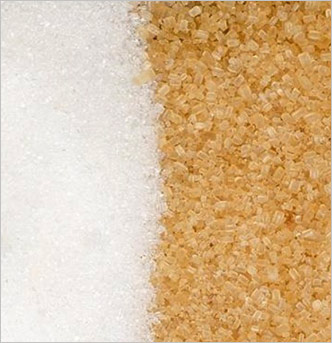 WHITE SUGAR : WHITE SUGAR :Pure sucrose naturally found in many fruits and vegetables. In nature, it can be found in either sugar cane or sugar beets, but by the time it has been refined to a white crystal, the two are chemically identical. To make white sugar, sulphur dioxide is added to cane juice before it gets evaporated. This gas does the bleaching of the juice so that it does not turn brown and produces white sugar. At later stages, phosphoric acid, calcium hydroxide or carbon dioxide is added to absorb impurities. This juice is then filtered through a bed of carbon and then crystallised in a vacuum many times. Finally the crystals are left to dry on their own to get paper white crystals of sugar. RAW SUGAR : To make sugar, machines are used: sugar cane (or sugar beet) is initially pressed and the juice is then mixed with lime to achieve the desired ph balance and to help settle out impurities. Reduction of this solution through evaporation produces a solid mass that is passed through centrifuge to get sugar crystals. It is then dried further to produce granules. This sugar is light brown in colour and is termed raw sugar. The brown colour of raw sugar is due to presence of molasses. Raw sugar is the most natural sugar you can hope to lay your hands on. BROWN SUGAR : Brown sugar is simply refined white sugar with a molasses syrup mixed in, then dried again. Brown sugar contains 95 per cent sucrose and 5 per cent molasses, which adds a lovely toffee flavour and moistness but no great nutritional benefits over white sugar. |
DIFFERENCES : WHITE SUGAR, RAW SUGAR AND BROWN SUGAR
Posted in Articles.
